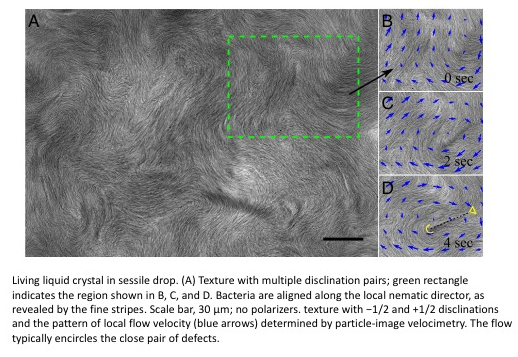Living Liquid Crystals: Difference between revisions
(New page: ==Example Patterns== frame|center ==Specifications== {| style= "width:500px; height:75px" align = "center" ! ! Theoretical ! Empirical |- align = "center" ! Pix...) |
|||
| Line 2: | Line 2: | ||
[[Image:LLCfigure1.png|frame|center]] | [[Image:LLCfigure1.png|frame|center]] | ||
Image courtesy of Zhou et al. 2014 | |||
==Specifications== | ==Specifications== | ||
Latest revision as of 14:48, 14 December 2015
Example Patterns

Image courtesy of Zhou et al. 2014
Specifications
| Theoretical | Empirical | |
|---|---|---|
| Pixel Dimension | 0.5 um X 5 um | |
| Pattern Size | 1 mm X 1 mm |
Mechanism
Liquid crystals are liquids in which molecules are oriented in a crystal-like way. They are widely used in displays (such as in your LCD TV) and as thermometers(1). Liquid crystals are also used for imaging, stress sensing, and digital storage. Living liquid crystals are liquid crystals in which the molecules are alive. Therefore, many more liquid crystal behaviors are accessible by energy input and interactions between the living molecules.
Biology is full of living liquid crystals; however, there are only a handful of studies on the self organization of crystal patterns in biology(2). Zhou et al. 2014 have created their own living liquid crystal system with bacteria as the living molecules(3). They are able to achieve several dynamic patterns by controlling oxygen levels and temperature.
Reference/Resources
- H. Kawamoto, The History of Liquid-Crystal Displays. Proceedings of the IEEE, 1–41 (2001).
- I. H. Riedel, K. Kruse, J. Howard, A self-organized vortex array of hydrodynamically entrained sperm cells. Science (2005), doi:10.1126/science.1113465.
- S. Zhou, A. Sokolov, O. D. Lavrentovich, I. S. Aranson, Living liquid crystals. Proceedings of the National Academy of Sciences. 111, 1265–1270 (2014).